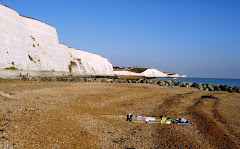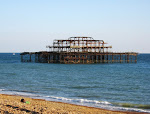
Last Saturday I escaped the horribly close weather we are having in London, and headed north to Loughborough for a day out. Now, most people will only know Loughborough from its University, famous for engineering and sport. But this otherwise unremarkable Midlands town has another thing going for it: the Great Central Railway.
The Great Central is generally regarded as one of the best of the UK's heritage steam railways. It is unique in preserving a former section of a main line, and having double track running, enabling it to recreate the great age of steam-hauled expresses. (Other preserved lines tend to be former branch lines).
Its history goes back to the mid-19th Century, and the vision of Edward Watkin. He envisaged a railway running from Manchester and Sheffield, via a new high speed main line, through London to Dover and then under the Channel Tunnel and thence to France. The line would be built to the larger European loading gauge, enabling the wider, longer and taller Continental carriages to run through directly to the North of England. And all this in the 1860s!
Watkin was Chairman of the Manchester, Sheffield and Lincolnshire Railway, the South Eastern Railway (connecting London with Dover), and also the Metropolitan Railway, so he was ideally placed to make the vision happen. A brand new line was built to link these various companies, from Sheffield down to the end of the Metropolitan line in London. The 'London extension', as it was called, was the last 19th century main line built into London, and opened through to Marylebone Station in 1899. It was renamed the 'Great Central Railway,' and quickly became famous for its fast and comfortable expresses.
Alas, the Channel Tunnel vision had to wait nearly another century before becoming reality, thanks to cost, engineering and security concerns. The Great Central was in many ways a successful line, although the company was never able to pay a dividend. But being a latecomer, and traversing the territory of more established companies, was to be its downfall: it became a victim of the 1966 cuts in British Railways, and was the only complete main line to be closed - ironically, the most modern and the only one built to the European loading gauge!
In 1969 some enthusiasts got together to reopen part of the line, and after a lot of hard work the trains started running again in 1973. The railway now runs from Loughborough to the northern outskirts of Leicester. It has a large collection of steam locomotives, from every pre-1947 company, as well as British Railway standard designs, and a wide range of preserved diesel trains and railcars. This varied collection is a delight for the enthusiast, and really helps to recreate the feel of railway in the early 1960s.
The stations are delightful: Loughborough recreates a large, busy town station of the early 1960s, Quorn & Woodhouse recreates the railway in wartime of the 1940s, and Rothley, the Edwardian period. Quorn & Woodhouse and Rothley are both excellent examples of the Great Central's standard design of small stations with a single island platform.
The line is double track from Loughborough to Rothley, allowing a real taste of how a main line railway would have felt in the 1960s. It runs through rolling countryside and passes on two viaducts over part of the lovely Swithland Reservoir (something of a hidden gem itself). All stations have some form of refreshment facilities, and there is a souvenir shop and bookshop at Loughborough.
Apart from the trains, additional attractions include the locomotive shed and workshops at Loughborough and the Ellis tearoom and miniature railway at Rothley. Also at Rothley are the workshops of the Railway Vehicle Preservation group, who aim to preserve rolling stock such as carriages (vital work, of course, but lacking the glamour of locomotive preservation). Their pride is two sets of Travelling Post Offices, and they organise week-ends demonstrating the old automatic mail drop-off and pick-up system, made famous by the 1950s film 'The Night Mail'.
The current southern terminus is Leicester North, just south of the site of the former Belgrave & Birstall station. There are plans to extend both further south into Leicester, and northwards to join up with a section of line still extant towards Ruddington and the outskirts of Nottingham. At present there is a gap of over 300m between the two sections, with an embankment and several bridges missing.
As you would expect, the line is extraordinarily popular with 'children of all ages'. They run a number of special 'themed' days, some suitable for the die-hard enthusiast, (eg Travelling Post Office demonstration) and others orientated more towards children (eg Thomas the Tank Engine days and Santa Specials).
As it is a full working railway, children must be appropriately supervised, and the locomotive shed is messy underfoot - stout footwear would be a good idea, and it is not really suitable for small children. Full details of access and parking can be found on the Line's website.
For further details, see their website at: www.gcrailway.co.uk
The Great Central is generally regarded as one of the best of the UK's heritage steam railways. It is unique in preserving a former section of a main line, and having double track running, enabling it to recreate the great age of steam-hauled expresses. (Other preserved lines tend to be former branch lines).
Its history goes back to the mid-19th Century, and the vision of Edward Watkin. He envisaged a railway running from Manchester and Sheffield, via a new high speed main line, through London to Dover and then under the Channel Tunnel and thence to France. The line would be built to the larger European loading gauge, enabling the wider, longer and taller Continental carriages to run through directly to the North of England. And all this in the 1860s!
Watkin was Chairman of the Manchester, Sheffield and Lincolnshire Railway, the South Eastern Railway (connecting London with Dover), and also the Metropolitan Railway, so he was ideally placed to make the vision happen. A brand new line was built to link these various companies, from Sheffield down to the end of the Metropolitan line in London. The 'London extension', as it was called, was the last 19th century main line built into London, and opened through to Marylebone Station in 1899. It was renamed the 'Great Central Railway,' and quickly became famous for its fast and comfortable expresses.
Alas, the Channel Tunnel vision had to wait nearly another century before becoming reality, thanks to cost, engineering and security concerns. The Great Central was in many ways a successful line, although the company was never able to pay a dividend. But being a latecomer, and traversing the territory of more established companies, was to be its downfall: it became a victim of the 1966 cuts in British Railways, and was the only complete main line to be closed - ironically, the most modern and the only one built to the European loading gauge!
In 1969 some enthusiasts got together to reopen part of the line, and after a lot of hard work the trains started running again in 1973. The railway now runs from Loughborough to the northern outskirts of Leicester. It has a large collection of steam locomotives, from every pre-1947 company, as well as British Railway standard designs, and a wide range of preserved diesel trains and railcars. This varied collection is a delight for the enthusiast, and really helps to recreate the feel of railway in the early 1960s.
The stations are delightful: Loughborough recreates a large, busy town station of the early 1960s, Quorn & Woodhouse recreates the railway in wartime of the 1940s, and Rothley, the Edwardian period. Quorn & Woodhouse and Rothley are both excellent examples of the Great Central's standard design of small stations with a single island platform.
The line is double track from Loughborough to Rothley, allowing a real taste of how a main line railway would have felt in the 1960s. It runs through rolling countryside and passes on two viaducts over part of the lovely Swithland Reservoir (something of a hidden gem itself). All stations have some form of refreshment facilities, and there is a souvenir shop and bookshop at Loughborough.
Apart from the trains, additional attractions include the locomotive shed and workshops at Loughborough and the Ellis tearoom and miniature railway at Rothley. Also at Rothley are the workshops of the Railway Vehicle Preservation group, who aim to preserve rolling stock such as carriages (vital work, of course, but lacking the glamour of locomotive preservation). Their pride is two sets of Travelling Post Offices, and they organise week-ends demonstrating the old automatic mail drop-off and pick-up system, made famous by the 1950s film 'The Night Mail'.
The current southern terminus is Leicester North, just south of the site of the former Belgrave & Birstall station. There are plans to extend both further south into Leicester, and northwards to join up with a section of line still extant towards Ruddington and the outskirts of Nottingham. At present there is a gap of over 300m between the two sections, with an embankment and several bridges missing.
As you would expect, the line is extraordinarily popular with 'children of all ages'. They run a number of special 'themed' days, some suitable for the die-hard enthusiast, (eg Travelling Post Office demonstration) and others orientated more towards children (eg Thomas the Tank Engine days and Santa Specials).
As it is a full working railway, children must be appropriately supervised, and the locomotive shed is messy underfoot - stout footwear would be a good idea, and it is not really suitable for small children. Full details of access and parking can be found on the Line's website.
For further details, see their website at: www.gcrailway.co.uk



2 comments:
Excellent article, However, the url is http://www.gcrailway.co.uk/ not .com
Such a shame especially the demolition of the grand station in Nottingham. Last main station built and first demolished :-(
Many thanks for the correction, Geoff. Yes, the demolition of so many great stations (on this and other lines) was such a shame. At least they found new uses for some, like the GMex in Manchester.
Post a Comment